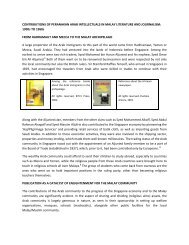The Transmission and Impact of the Hadhrami and Persian ... - Rihlah
The Transmission and Impact of the Hadhrami and Persian ... - Rihlah
The Transmission and Impact of the Hadhrami and Persian ... - Rihlah
You also want an ePaper? Increase the reach of your titles
YUMPU automatically turns print PDFs into web optimized ePapers that Google loves.
Plate (iii) [a] Sassanian Lute (barbat?) A.D. 224 Plate (iii) [b] Greco-G<strong>and</strong>hara lute A.D. 100<br />
<strong>The</strong> Malays may have adopted <strong>the</strong> generic term gambus to refer to <strong>the</strong> <strong>Persian</strong> barbat,<br />
<strong>the</strong> Arabian qanbus (qabus) <strong>and</strong> ūd, found in alam melayu. 11 <strong>The</strong> word gambus may<br />
originally have referred to a <strong>Persian</strong> lute with a pear-shaped body, skin belly <strong>and</strong> a “C”<br />
shaped peg-box as shown in Fig.1 “C” Shaped Pegbox. 12<br />
Fig. 1 “C” Shaped Pegbox<br />
<strong>The</strong> Early Migration <strong>of</strong> <strong>the</strong> <strong>Hadhrami</strong> <strong>and</strong> <strong>Persian</strong> Lute-Type Instruments<br />
11 This point about <strong>the</strong> probable Arabic word “gambus” being borrowed by <strong>the</strong> Malays to describe <strong>the</strong> <strong>Persian</strong> lute<br />
was unanimously <strong>the</strong> opinion expressed by Malay Language specialists at Nanyang Technological<br />
University/National Institute <strong>of</strong> Education in Singapore (personal communication: April 1997).<br />
12 While visiting <strong>the</strong> British Museum, I came across a silver plate [see Plate (ii[a]) showing a banqueting scene<br />
from <strong>the</strong> 3rd –7th century Sassanian Period (Persia [Iran]). This is <strong>the</strong> only evidence <strong>of</strong> <strong>the</strong> “barbat” in visual form<br />
that I have seen (16th May 2001). <strong>The</strong> design on <strong>the</strong> plate depicted a musician playing a lute-type instrument that<br />
looked similar to <strong>the</strong> gambus Melayu. This could also be <strong>the</strong> lute-type instrument that Farmer, During (1984) <strong>and</strong><br />
Zonis (1973) were referring to as <strong>the</strong> barbat from Persia. Similar lute instruments to those <strong>of</strong> <strong>the</strong> Sassanid period<br />
were also found during <strong>the</strong> Greco-G<strong>and</strong>hara [see Plate (ii[b]) period (c.100 A.D.) This picture <strong>of</strong> <strong>the</strong> G<strong>and</strong>hara<br />
lute was taken from Sachs (1940: plate IX (B):160) <strong>and</strong> Marcuse (1975: 410). <strong>The</strong>se pictorial facts on <strong>the</strong> barbat<br />
are some <strong>of</strong> <strong>the</strong> conclusive evidence, which match <strong>the</strong> documentary descriptions.<br />
5




